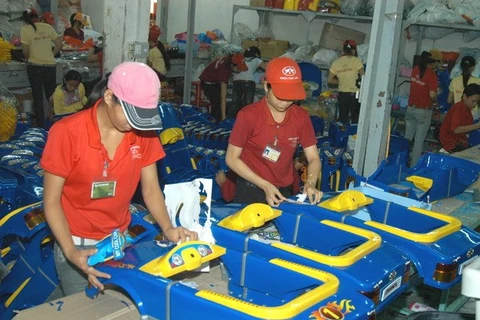 Visitors examine a new machine at the 15th Vietnam International Plastic Rubber Industry Exhibition in Ho Chi Minh City. Photo: VNA
Visitors examine a new machine at the 15th Vietnam International Plastic Rubber Industry Exhibition in Ho Chi Minh City. Photo: VNA Companies in the plastics industry should apply advanced technologies to maintain competitiveness after the ASEAN Economic Community (AEC) takes effect by year-end, speakers at a seminar said on September 17.
Le Ngoc Trung, Deputy Head of the Ministry for Industry and Trade's Southern Operation Department, said that plastics small- and medium-sized enterprises must map out long-term business strategies.
The seminar, held by the Vietnam Business Forum in collaboration with Chan Chao Company, discussed how the plastics industry could adapt to the AEC, a single market with 600 million consumers.
Nguyen Thanh Binh, Director of the Business Information Centre of the Vietnam Chamber of Commerce and Industry, said that tariffs slated for elimination under the ASEAN Free Trade Agreement would be made ahead of the originally scheduled time in 2018.
Tariff rates would drop to zero percent for 80 percent of tax lines. At least 13-15 percent of tariffs would be removed. The rest will be removed gradually until 2018.
The AEC aims to establish a single common market and production base for ASEAN-member countries which will enable the free movement of goods, services, capital and skilled labour within ASEAN. Vietnamese businesses will be able to take advantage of the AEC to import goods at competitive prices and participate in the regional supply chain.
To improve competitiveness, however, the country must use advanced and environmentally friendly technology and take part in R&D activities.
The plastics industry should modernise by gradually eliminating old equipment and technologies and replace them with massive automation, speakers at the seminar said.
This would help pave the way for innovative changes in manufacturing.
Last year, Vietnam imported 3.4 million tonnes of raw materials for plastic goods, accounting for more than 80 percent of demand.
Quach The Phong, consulting director of Ipsos Market Research Ltd Co, said the heavy reliance on raw-material imports made it difficult for Vietnamese manufacturers to lower production costs, thus leading to poor competitiveness with other countries.
The production capacity of domestic plastics manufacturers is not large enough, and has many limitations as well, including mass production capacity, technology, machinery and labour. As a result, companies cannot accept big orders.
Another challenge is a lack of labour, especially skilled workers who can operate new-generation equipment.
About 150,000 labourers work in the plastics industry, but only 70 percent of them can operate modern equipment.-VNA






















